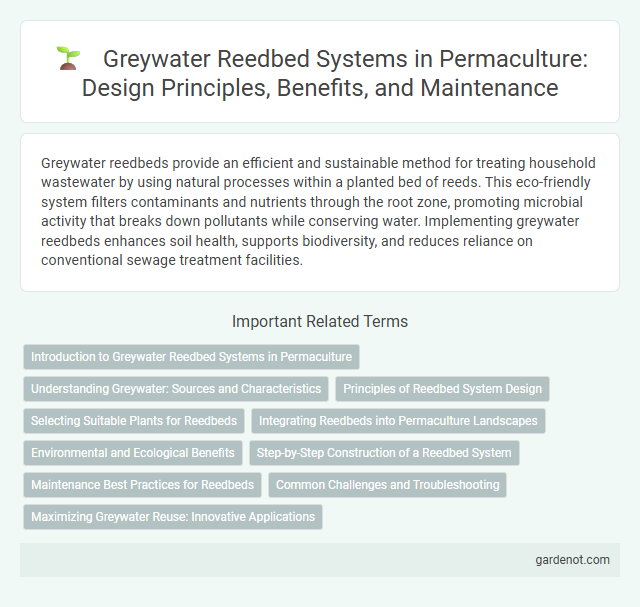Greywater reedbeds provide an efficient and sustainable method for treating household wastewater by using natural processes within a planted bed of reeds. This eco-friendly system filters contaminants and nutrients through the root zone, promoting microbial activity that breaks down pollutants while conserving water. Implementing greywater reedbeds enhances soil health, supports biodiversity, and reduces reliance on conventional sewage treatment facilities.
Introduction to Greywater Reedbed Systems in Permaculture
Greywater reedbed systems in permaculture use natural filtration through reeds and substrate to treat household greywater, reducing environmental impact and recycling nutrients for irrigation. These systems combine engineered wetlands with sustainable design principles, promoting water conservation and soil health by breaking down organic matter and contaminants. By integrating reedbeds, permaculture practitioners enhance onsite wastewater management, support biodiversity, and create resilient, closed-loop ecosystems.
Understanding Greywater: Sources and Characteristics
Greywater originates from household activities such as laundry, bathing, and dishwashing, containing lower levels of contaminants compared to blackwater. This wastewater typically carries organic matter, detergents, and trace nutrients, making it suitable for treatment through biological systems like reedbeds. Understanding the chemical composition and microbial load of greywater is essential for optimizing greywater reedbed design and ensuring effective filtration and nutrient recycling in permaculture systems.
Principles of Reedbed System Design
Greywater reedbed systems utilize natural filtration processes driven by plant roots, microbial activity, and sediment layers to treat household wastewater sustainably. Key principles include optimizing hydraulic loading rates for efficient water flow, selecting appropriate reed species like Phragmites australis for effective nutrient uptake and pollutant removal, and designing substrate layers to maximize microbial degradation and sediment retention. Proper spacing, flow control mechanisms, and periodic system maintenance ensure long-term functionality and support permaculture goals of water conservation and ecosystem health.
Selecting Suitable Plants for Reedbeds
Selecting suitable plants for greywater reedbeds involves prioritizing species with high filtration capacity and tolerance to fluctuating water levels, such as common reed (Phragmites australis), bulrush (Schoenoplectus spp.), and cattails (Typha spp.). These plants effectively absorb pollutants, stabilize substrates, and promote microbial activity essential for water purification. Choosing native or well-adapted species enhances ecosystem resilience and minimizes maintenance requirements in permaculture greywater management systems.
Integrating Reedbeds into Permaculture Landscapes
Integrating greywater reedbeds into permaculture landscapes enhances sustainable water management by naturally filtering household wastewater through dense reed roots and microbial activity. These reedbeds reduce pollution, recycle nutrients, and support biodiversity by creating wetland habitats that attract beneficial insects and birds. Combining greywater treatment with edible and ornamental plant species within permaculture designs maximizes resource efficiency and promotes ecological resilience.
Environmental and Ecological Benefits
Greywater reedbeds enhance permaculture systems by naturally filtering household wastewater through dense reed roots, promoting microbial activity that breaks down pollutants and reduces contamination risks. These systems conserve freshwater resources by recycling greywater for irrigation, reducing strain on natural water bodies and supporting sustainable water management. The reedbeds also create habitats for diverse wildlife, increasing local biodiversity and improving ecosystem resilience.
Step-by-Step Construction of a Reedbed System
Constructing a greywater reedbed system involves excavating a shallow basin lined with impermeable material to prevent groundwater contamination. Gravel and sand layers are then added to support Phragmites australis or common reed planting, which naturally filters and breaks down pollutants. The system requires installing inlet and outlet pipes to control greywater flow, ensuring efficient treatment and reuse in permaculture landscapes.
Maintenance Best Practices for Reedbeds
Maintaining greywater reedbeds involves regular inspection to prevent blockages and ensure proper water flow through the system. Periodic removal of accumulated sediment and dead plant material helps sustain the reedbed's filtration efficiency and plant health. Monitoring water quality parameters such as pH, nutrient levels, and contaminants ensures the greywater treatment process remains effective and safe for reuse or discharge.
Common Challenges and Troubleshooting
Greywater reedbeds often face challenges such as clogging caused by accumulated solids and root intrusion, which can reduce water flow and treatment efficiency. Inadequate system design or poor maintenance leads to odors and uneven water distribution, necessitating regular inspection and removal of debris to sustain optimal performance. Troubleshooting focuses on balancing hydraulic loads, ensuring proper pre-filtration, and promoting healthy reed growth to maintain effective greywater treatment.
Maximizing Greywater Reuse: Innovative Applications
Greywater reedbeds efficiently treat household wastewater by leveraging natural filtration through reeds and substrate, significantly reducing water pollution while enabling safe reuse for irrigation and landscaping. Innovative applications incorporate modular reedbed systems tailored for urban permaculture, enhancing water recycling in limited spaces and promoting sustainable water management. These systems optimize greywater reuse by improving nutrient absorption and biodegradation, supporting eco-friendly water cycles within permaculture designs.
Greywater reedbed Infographic

 gardenot.com
gardenot.com